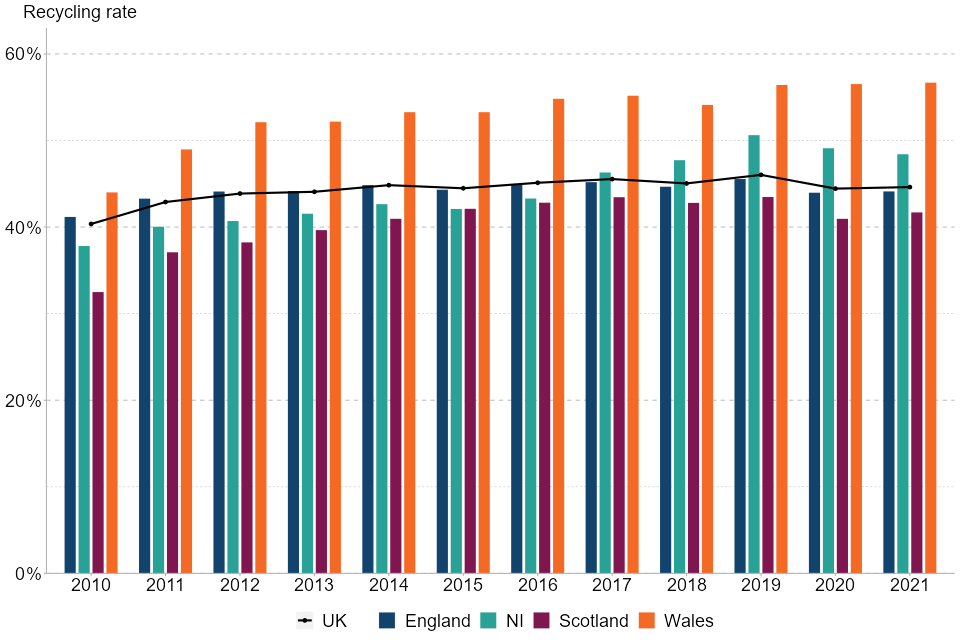Recycling
Recycling is defined as any recovery operation by which waste materials are reprocessed into products, materials or substances whether for the original or other purposes. It includes the reprocessing of organic material (e.g. Composting, Anaerobic Digestion etc.) but excludes energy recovery and the reprocessing into materials that are to be used as fuels or for Backfilling operations.’ [1] [2]. Materials recovered for onward recycling/processing are often termed 'recylables' and 'recyclates', especially in the context of dry recyclables such as Paper, Cardboard, Plastic Bottles, Drinks Cans and Glass Bottles.
Collection
Collection systems for materials that can be recycled varies by location across the UK, a range of factors influence the collection scheme that is employed for a region including whether the area is rural or urban and the type of housing and facilities in the area and for businesses the types of waste and the space they have for recycling. There are three broad collection schemes in the UK:
In the case where Dry Recyclables materials are separately collected as part of a Kerbside Collection, or at a HWRC site, they are generally termed source segregated recyclate. Where dry recyclables are mixed, i.e. Twin Stream Collection and Comingled Collection, the materials tend to be termed Dry Mixed Recyclables and require some form of onward processing (see below).
Materials
Whilst the materials can include a wide range of recycled materials, as per the above definition, the main materials are reported as follows:
- Collected Dry Recyclables (either as separate Dry Recyclables or Dry Mixed Recyclables) which typically comprise:
- Organic Waste which typically comprises:
- Food Waste (typically sent to Anaerobic Digestion)
- Green Waste (typically sent for composting) and
- Mixed Food Waste and Green Waste (typically sent to In Vessel Composting)
- Other Recyclable materials (typically collected at HWRC sites) include:
The move towards Consistency in Recycling Collections in England[4] is progressing towards a uniform approach to materials collected for recycling for Household Waste and Non-Household Municipal Waste.
Process
Following collection and sorting, recyclable materials are sent for reprocessing. This generally occurs at a Material Recovery Facility (MRF) for DMR materials. Mixed recycling streams are sorted into different material types at MRFs, either mechanically or by hand, ready for the materials to then be sent to manufacturers to make it into new products. Once recyclable materials are sorted, they are then classified as valuable commodities in the worldwide markets[3].
In a Circular Economy, the value of products and materials is maintained for as long as possible. Within the circularity discussions both 'Closed' and 'Open' loops are referred to:
- Closed Loop Recycling (where the recycled material is used to make another product in the same category i.e. plastic water bottles being used to make new plastic bottles)
- Open Loop Recycling (where recycled material is used in a different application in a different product i.e. plastic water bottles being used to make fleeces and sleeping bags)
Performance for Household Waste
The UK household waste recycling rate (including IBA metal) was 44.6% in 2021[5], and 44.2% in 2020, decreasing from 46.0% in 2019. [2].

The UK household waste recycling rate (excluding IBA metal) from 2010 - 2020 is shown below.

Performance for Non-Household Waste
The recycling rate for CD&E Waste is generally reported as a recovery rate, and was 9.23% for the UK in the most recent DEFRA 2022 data release[2].
For Commercial and Industrial Waste the recovery and recycling rates are less accurately understood and reported, as many of the facilities that handle the recyclable materials are exempt from permitting and the associated reporting requirements. As a result, the data is less consistent and has a methodology applied to assess arisings etc[6]. Whilst packaging waste recycling was reported at around 70%, the range of opinion on recycling of Commercial and Industrial Waste was captured in an overview report by Tolvik for the ESA[7] at between 47% and 65%, with a mean recycling rate of around 61% of all reported assumptions.
References
- ↑ [1] Waste Framework Directive 2008
- ↑ 2.0 2.1 2.2 [2] DEFRA Digest Data Published May 2022
- ↑ 3.0 3.1 Recycle Now, 2020. Recycling collections | Recycle Now. Online. Recyclenow.com. [Accessed 3 Mar. 2020.]
- ↑ Consultation on Consistency in Household and Business Collection
- ↑ https://www.gov.uk/government/statistics/uk-waste-data/uk-statistics-on-waste#impact-of-coronavirus-covid-19
- ↑ Commercial and Industrial Waste Arisings Methodology Revisions for England
- ↑ UK Residual Waste: 2030 Market Review
